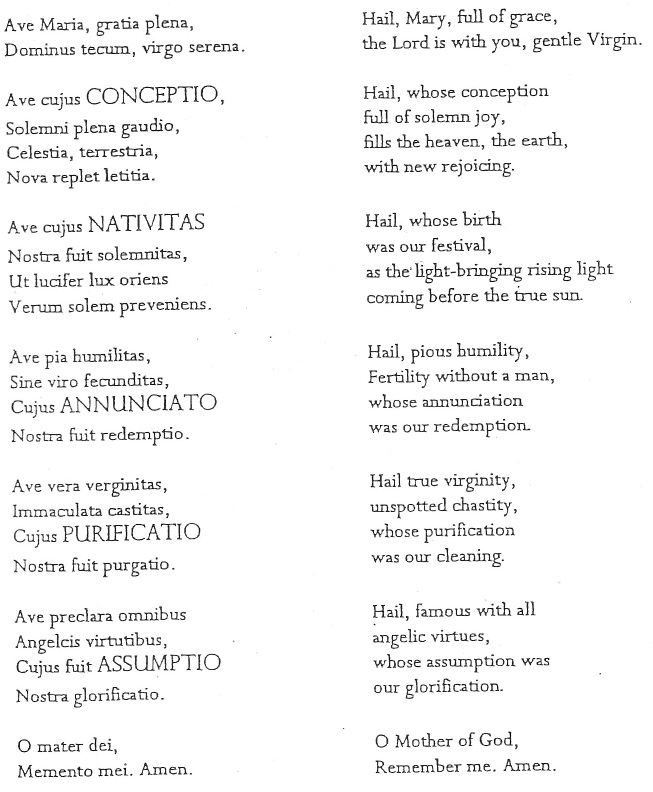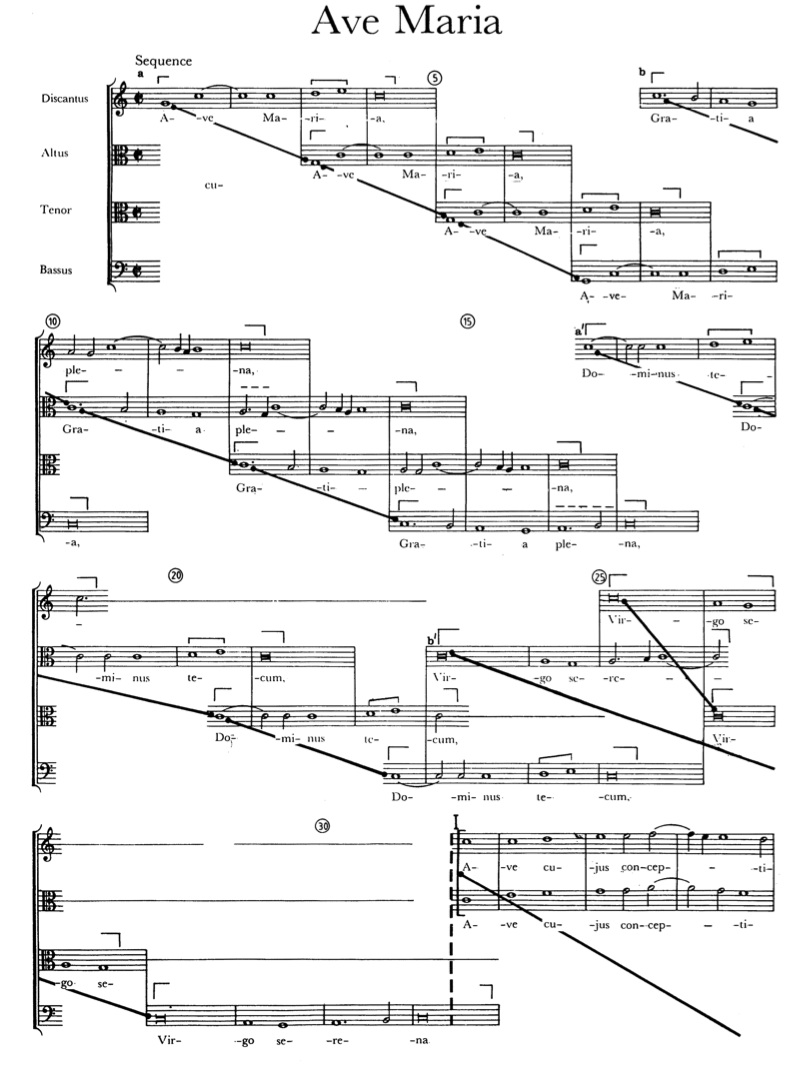.
Josquin Des Prez (c. 1450 to 1455– 27 August 1521)
1. Ave Maria is a Motet.
Here is the full piece:
[audio:http://www.jaimeoliver.pe/snd/mh/josquin/ave-maria.mp3]You can download an mp3 version here.
If you’re interested, you can see a score here.
Here is the text to which the music is set to:
Q.1.1 Think about what the language is and what does that imply?
Q.1.2 What is the text about?
Q.1.3 Why are certain words in Capital Letters? think for example about annunciation or conception and their portrayal in the visual arts.
The text of Ave Maria is a rhymed, metric, five-strophe hymn, framed at the beginning by the opening text of a Sequence (‘Ave Maria, virgo serena, gratia plena, Dominus tecum’) and at the end by an independent phrase (‘O Mater Dei, memento mei. Amen.’)
Q.1.4 What do you think the word frame means in this context?
2. FORM:
If you notice, the music can be divided into 7 parts. Here are the 7 sections in case you want to listen to any of them in particular:
[audio:http://www.jaimeoliver.pe/snd/mh/josquin/ave-maria-01.mp3] [audio:http://www.jaimeoliver.pe/snd/mh/josquin/ave-maria-02.mp3] [audio:http://www.jaimeoliver.pe/snd/mh/josquin/ave-maria-03.mp3] [audio:http://www.jaimeoliver.pe/snd/mh/josquin/ave-maria-04.mp3] [audio:http://www.jaimeoliver.pe/snd/mh/josquin/ave-maria-05.mp3] [audio:http://www.jaimeoliver.pe/snd/mh/josquin/ave-maria-06.mp3] [audio:http://www.jaimeoliver.pe/snd/mh/josquin/ave-maria-07.mp3]You can notice that a part or section has ended because you find a cadence.
Q.2.1 Is it a coincidence that the music has the same number of parts than the text? To what extent is the music dependent on the text to acquire its form?
Here are the cadences of the seven sections:
[audio:http://www.jaimeoliver.pe/snd/mh/josquin/cadences.mp3]Q.2.2 Can you hear the sense of closure in each of these cadences?
Another aspect to form is the variation in texture. The terms we use for texture are: monophonic, homophonic, and polyphonic (imitative and non-imitative).
**** Notice that these terms in Sonic Glossary are now available as podcasts, so you can download the tracks and listen to them in your mp3 players.
3. Section 1
Here is Section 1:
[audio:http://www.jaimeoliver.pe/snd/mh/josquin/ave-maria-01.mp3]This is an example of imitative polyphony. Try to listen for this imitation seeing the following visual aid:
Q.3 What, in your opinion is the meaning of imitative polyphony given the words of the text?
4. Section 7
Here is Section 1:
[audio:http://www.jaimeoliver.pe/snd/mh/josquin/ave-maria-07.mp3]This is an example of homophony.
Q.4 How does the text relate to the texture?
5. Word painting:
A common technique in text-based music is the use of a technique called word painting. Listen carefully to section 3 again:
[audio:http://www.jaimeoliver.pe/snd/mh/josquin/ave-maria-04.mp3]Q.5 How is the idea of humility “painted” in this section?
6. Tonal Center:
Now listen to this shorter version of the seven cadences and think about what is similar between all of these cadences:
[audio:http://www.jaimeoliver.pe/snd/mh/josquin/cadences-2.mp3]Q.6 what do you think I mean by Tonal Center?

